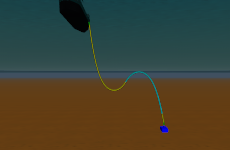A04 Disconnecting turret system
This model represents an FPSO system with a releasable turret. Disconnecting systems are found in regions where typhoons or ice flows are common. It allows the vessel to be removed until conditions improve.
The turret can be lowered from the vessel with winches. However, downtime is expensive, so operators prefer to keep producing until the last moment before disconnecting the turret and departing the field. The turret drops below the severe weather until the FPSO returns to reconnect.
The turret system needs to be designed so there are acceptable responses in all three phases.
- Connected - the turret is attached to the vessel and moves with it.
- Disconnecting - the flexibles are disconnected from topside and the turret is released.
- Disconnected - the turret is settled deeper in the water.




